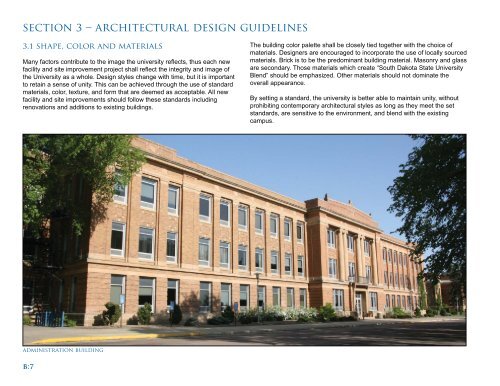2025 Design & Master Plan - South Dakota State University
2025 Design & Master Plan - South Dakota State University 2025 Design & Master Plan - South Dakota State University
section 3 – architectural design guidelines 3.1 shape, color and materials Many factors contribute to the image the university reflects, thus each new facility and site improvement project shall reflect the integrity and image of the University as a whole. Design styles change with time, but it is important to retain a sense of unity. This can be achieved through the use of standard materials, color, texture, and form that are deemed as acceptable. All new facility and site improvements should follow these standards including renovations and additions to existing buildings. The building color palette shall be closely tied together with the choice of materials. Designers are encouraged to incorporate the use of locally sourced materials. Brick is to be the predominant building material. Masonry and glass are secondary. Those materials which create “South Dakota State University Blend” should be emphasized. Other materials should not dominate the overall appearance. By setting a standard, the university is better able to maintain unity, without prohibiting contemporary architectural styles as long as they meet the set standards, are sensitive to the environment, and blend with the existing campus. administration building b:7
3.2 building size Buildings should be in scale with the surrounding structures along with the public spaces that are adjacent to them. Proportion, massing and scale of all new construction shall correspond similarly to nearby buildings and general campus character. Scale should acknowledge surrounding context and establish the human scale. Consider both pedestrian scale at the face of buildings and from viewing corridors afar. The ratio of building height to open space shall be 1:1.5 or 1:2 to create comfortable enclosed spaces rather than wide open sprawl. This should be accomplished using two- to four-story buildings. Building height should complement surrounding architecture. 3.3 facade proportion The scale and proportion of a building impacts the sense of place within the campus. New buildings and additions should acknowledge surrounding context, but recognize and establish human scale. The design of the building should take into consideration how the design affects a person standing at the face of the structure; similarly the building’s materials can influence how the building scale is read. Building facades that face major pedestrian malls should be treated as front porches with seating, plantings, lights, etc. Entrances should be emphasized. Areas of pedestrian proximity should be given the most consideration, including building entries, arcades, shade elements and first-story features on multistory buildings. lincoln music hall b:8
- Page 27 and 28: general parking development costs C
- Page 29 and 30: figure 3.6: concept view “a” of
- Page 31 and 32: 3.5 pedestrian corridors freeing th
- Page 33 and 34: 3.6 implementation The implementati
- Page 35 and 36: phase 2: residential life southeast
- Page 37 and 38: phase 4: academic core (math and en
- Page 39 and 40: phase 6: athletic and academic core
- Page 41 and 42: acknowledgements Two committees wer
- Page 44 and 45: table of contents INTRODUCTION A:1
- Page 46 and 47: section 1 - parking lots Parking lo
- Page 48 and 49: figure 1.3: typical parking lot sec
- Page 50 and 51: figure 2.4: bike lane on two-way st
- Page 52 and 53: figure 3.3: campus standard parking
- Page 54 and 55: section 5 - campus wayfinding signa
- Page 56 and 57: section 7 - site walls When the bud
- Page 58 and 59: section 9 - general landscape desig
- Page 60 and 61: planting methods Use suitable topso
- Page 62 and 63: turfgrass All new turf seed and sod
- Page 64 and 65: ornamental trees Scientific Name Co
- Page 66 and 67: seating nodes Seating nodes along p
- Page 68 and 69: ermed turf areas Bermed turf areas,
- Page 71 and 72: table of contents INTRODUCTION B:1
- Page 73 and 74: section 1 - purpose and intent of g
- Page 75 and 76: Facility construction and improveme
- Page 77: 2.3 stewardship Stewardship is the
- Page 81 and 82: 3.5 building types The campus conta
- Page 83 and 84: section 4 - campus architectural im
- Page 85: performing arts center university s
section 3 – architectural design guidelines<br />
3.1 shape, color and materials<br />
Many factors contribute to the image the university reflects, thus each new<br />
facility and site improvement project shall reflect the integrity and image of<br />
the <strong>University</strong> as a whole. <strong>Design</strong> styles change with time, but it is important<br />
to retain a sense of unity. This can be achieved through the use of standard<br />
materials, color, texture, and form that are deemed as acceptable. All new<br />
facility and site improvements should follow these standards including<br />
renovations and additions to existing buildings.<br />
The building color palette shall be closely tied together with the choice of<br />
materials. <strong>Design</strong>ers are encouraged to incorporate the use of locally sourced<br />
materials. Brick is to be the predominant building material. Masonry and glass<br />
are secondary. Those materials which create “<strong>South</strong> <strong>Dakota</strong> <strong>State</strong> <strong>University</strong><br />
Blend” should be emphasized. Other materials should not dominate the<br />
overall appearance.<br />
By setting a standard, the university is better able to maintain unity, without<br />
prohibiting contemporary architectural styles as long as they meet the set<br />
standards, are sensitive to the environment, and blend with the existing<br />
campus.<br />
administration building<br />
b:7



